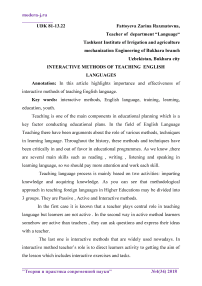Interactive methods of teaching English languages
Автор: Fattoyeva Z.R.
Журнал: Теория и практика современной науки @modern-j
Рубрика: Основной раздел
Статья в выпуске: 4 (34), 2018 года.
Бесплатный доступ
In this article highlights importance and effectiveness of interactive methods of teaching English language.
Interactive methods, english language, training, learning, education, youth
Короткий адрес: https://sciup.org/140273008
IDR: 140273008
Текст научной статьи Interactive methods of teaching English languages
Teaching is one of the main components in educational planning which is a key factor conducting educational plans. In the field of English Language Teaching there have been arguments about the role of various methods, techniques in learning language. Throughout the history, these methods and techniques have been critically in and out of favor in educational programmes. As we know ,there are several main skills such as reading , writing , listening and speaking in learning language, so we should pay more attention and work each skill.
Teaching language process is mainly based on two activities: imparting knowledge and acquiring knowledge. As you can see that methodological approach in teaching foreign languages in Higher Educations may be divided into 3 groups. They are Passive , Active and Interactive methods.
In the first case it is known that a teacher plays central role in teaching language but learners are not active . In the second way in active method learners somehow are active than teachers , they can ask questions and express their ideas with a teacher.
The last one is interactive methods that are widely used nowadays. In interactive method teacher’s role is to direct learners activity to getting the aim of the lesson which includes interactive exercises and tasks.
One of the best interactive methods is Brainstorming in which new ideas on a topic are generated by learners. This method stimulates creative activity of the learners in solving problems and express their ideas freckly .In brainstorming quantity of sentences is important but not quality. Teacher should listen to all sentences and not criticize them .Instead of this teacher inspires the learners to give many variants of solving problems as he can. At the end of brainstorming activity all the expressed sentences are written then analyzed.
The second method is Round table discussion. This type of interactive methods requires to study teaching material on the theme before starting discussion .After having learnt learners may start discussion . This method helps the learners consistently and logically express their ideas by presenting grounds for their utterances. There learners work in small groups and this improves their activity because every member of the group may express his or her ideas and takes part in the discussion.
Forms of organizing round table discussion are the following:
-
1 .The theme of the lesson is selected.
-
2 .The learners must learn the chosen problem before starting discussion.
-
3 .Teacher gives instruction and announces the limit of time.
-
4 .Learners in each group make discussion with groupmates.
-
5 .At the end of the discussion one member in each group makes presentation.
Cluster is also one of the best methods in teaching language now. It can be used in all stages of teaching English to both young and aged learners. In the presenting new word on the blackboard and then learners tell the words that can be used together with the given word. For example, ‘’technology’’ is given in center of the cluster. Learner should find the words belonging to technology. It can be effectively used in improving monologic speech habits and skills.
Without a shadow of a doubt, these methods are useful to improve the main skills such as speaking and listening and also increase the critical thinking ability.
Список литературы Interactive methods of teaching English languages
- Abduazimov A. A. T., 2006 "Theoretical Course"
- Crystal, David Camb., 1997 "English as a Global Language"
- Vasslyev V. A. M., 1970 "Theoretical Course".


